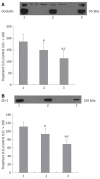Effects of cardiopulmonary bypass on tight junction protein expressions in intestinal mucosa of rats
- PMID: 18855986
- PMCID: PMC2751897
- DOI: 10.3748/wjg.14.5868
Effects of cardiopulmonary bypass on tight junction protein expressions in intestinal mucosa of rats
Abstract
Aim: To investigate the tight junction protein expressions of intestinal mucosa in an experimental model of cardiopulmonary bypass (CPB) in rats.
Methods: Thirty anesthetized rats were randomly divided into two groups: Group S (n = 10) served as sham operation and group C (n = 20) served as CPB which underwent CPB for 1 h. Expression of occludin and zonula occludens-1 (ZO-1) were determined by Western blotting and immunotochemistry, respectively. Plasma levels of diamine oxidase (DAO) and d-lactate were determined using an enzymatic spectrophotometry.
Results: Immunohistochemical localization of occludin and ZO-1 showed disruption of the tight junctions in enterocytes lining villi at the end of CPB and 2 h after CPB. The intensities of the occludin and ZO-1 at the end of CPB were lower than those of control group (76.4% +/- 22.5% vs 96.5% +/- 28.5% and 62.4% +/- 10.1% vs 85.5% +/- 25.6%, P < 0.05) and were further lower at 2 h after CPB (50.5% +/- 10.5% and 45.3% +/- 9.5%, P < 0.05). Plasma d-lactate and DAO levels increased significantly (8.688 +/- 0.704 vs 5.745 +/- 0.364 and 0.898 +/- 0.062 vs 0.562 +/- 0.035, P < 0.05) at the end of CPB compared with control group and were significantly higher at 2 h after CPB than those at the end of CPB (9.377 +/- 0.769 and 1.038 +/- 0.252, P < 0.05). There were significant negative correlations between occludin or ZO-1 expression and DAO (r(2) = 0.5629, r(2) = 0.5424, P < 0.05) or d-lactate levels (r(2) = 0.6512, r(2) = 0.7073, P < 0.05) both at the end of CPB and 2 h after CPB.
Conclusion: CPB markedly down-regulates the expression of occludin and ZO-1 proteins in intestinal mucosa of rats. The close correlation between expression of tight junctions (TJs) and plasma levels of DAO or d-lactate supports the hypothesis that intestinal permeability increases during and after CPB because of decreases in the expressions of TJs.
Figures




References
-
- Deitch EA. The role of intestinal barrier failure and bacterial translocation in the development of systemic infection and multiple organ failure. Arch Surg. 1990;125:403–404. - PubMed
-
- Ohri SK, Bjarnason I, Pathi V, Somasundaram S, Bowles CT, Keogh BE, Khaghani A, Menzies I, Yacoub MH, Taylor KM. Cardiopulmonary bypass impairs small intestinal transport and increases gut permeability. Ann Thorac Surg. 1993;55:1080–1086. - PubMed
-
- Riddington DW, Venkatesh B, Boivin CM, Bonser RS, Elliott TS, Marshall T, Mountford PJ, Bion JF. Intestinal permeability, gastric intramucosal pH, and systemic endotoxemia in patients undergoing cardiopulmonary bypass. JAMA. 1996;275:1007–1012. - PubMed
-
- Oudemans-van Straaten HM, Jansen PG, Hoek FJ, van Deventer SJ, Sturk A, Stoutenbeek CP, Tytgat GN, Wildevuur CR, Eysman L. Intestinal permeability, circulating endotoxin, and postoperative systemic responses in cardiac surgery patients. J Cardiothorac Vasc Anesth. 1996;10:187–194. - PubMed
-
- Oudemans-van Straaten HM, Jansen PG, te Velthuis H, Beenakkers IC, Stoutenbeek CP, van Deventer SJ, Sturk A, Eysman L, Wildevuur CR. Increased oxygen consumption after cardiac surgery is associated with the inflammatory response to endotoxemia. Intensive Care Med. 1996;22:294–300. - PubMed
MeSH terms
Substances
LinkOut - more resources
Full Text Sources
Molecular Biology Databases

